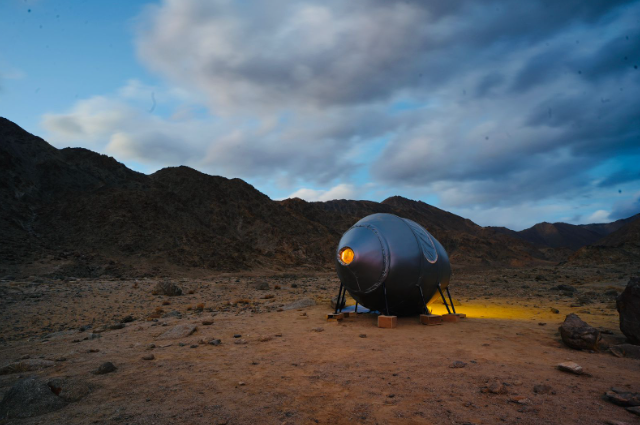The Indian Space Research Organisation (ISRO) announced the start of a groundbreaking space mission where India's very first analog space mission was taking place in the remote landscapes of Leh, Ladakh. The mission marks a significant step for India in the field of space research and exploration. Spearheaded by ISRO’s Human Spaceflight Centre, this mission represents a collective effort with key collaborators including AAKA Space Studio, the University of Ladakh, the prestigious IIT Bombay and supported locally by the Ladakh Autonomous Hill Development Council.
Purpose of the Analog Space Mission: Life Beyond Earth
The primary goal of this analog space mission is to explore what it would be like to live in an interplanetary environment—an essential area of research as humanity considers the possibility of establishing a base beyond our planet. By creating conditions that mimic life on other celestial bodies, scientists and researchers hope to better understand and address the numerous challenges that such habitats would entail. This includes studying the physical, psychological, and technological obstacles that humans would face in an off-Earth base station.
Collaboration Across Institutions to Tackle Space Challenges
This pioneering mission emphasizes a collaborative spirit in India's scientific community. ISRO’s Human Spaceflight Centre has brought together the talents and resources of various academic and scientific institutions. AAKA Space Studio, known for its innovations in space-related technologies has teamed up with the University of Ladakh which provides its geographical insights and local knowledge. IIT Bombay adds its research capabilities, further elevating the mission’s scientific rigour. Additionally, the Ladakh Autonomous Hill Development Council has offered its support by recognizing the mission’s potential benefits for local scientific development and its global impact.
ISRO’s Public Announcement: A Visionary Project for India
Sharing the mission update on X (formerly Twitter), ISRO expressed its enthusiasm by stating, “India's first analog space mission kicks off in Leh! A collaborative effort by Human Spaceflight Centre, ISRO, AAKA Space Studio, University of Ladakh, IIT Bombay, and supported by Ladakh Autonomous Hill Development Council, this mission will simulate life in an interplanetary habitat to tackle the challenges of a base station beyond Earth.” This statement reflects ISRO’s commitment to advancing India’s role in space exploration and its aspirations to tackle the pressing questions of human survival in outer space environments.
Moving Forward: A New Frontier for Indian Space Research
This analog space mission represents more than just scientific research; it marks a new frontier for India in the global space community. Through this mission, ISRO and its partners aim to gather invaluable insights that could inform future space missions including the establishment of permanent human habitats on other planets. As India continues to reach for the stars, the success of this analog mission will be a crucial step towards realizing humanity’s dreams of interplanetary life.
Exploring New Frontiers: Mars and Moon Conditions in Ladakh
A recent mission marks a significant advancement in our efforts to reproduce the environments found on Mars and the Moon. The region of Ladakh with its extreme remoteness, harsh weather, and distinctive geographical characteristics serves as an excellent location for simulating the difficulties astronauts might encounter on these distant worlds. This initiative is not just an isolated project; it plays a crucial role in gathering important data that will help India's Gaganyaan program and future endeavours in space exploration.
The Unique Environment of Ladakh
Ladakh's climate is characterized by dryness, high altitudes, and a rugged landscape that closely mirrors the conditions on Mars and the Moon. These similarities make it an ideal site for conducting analog research which is essential for preparing for space missions. Dr. Aloke Kumar who is a leading scientist in India was instrumental in suggesting that Ladakh be utilized for this type of space research by recognizing its potential to provide insights into extraterrestrial conditions.
Understanding Analog Missions
According to NASA, analog missions are essentially field tests conducted in environments on Earth that replicate the extreme conditions of space. These missions are vital as they allow researchers to study how humans, robots, and various technologies might behave under space-like circumstances. By conducting experiments in places like Ladakh, scientists can gather critical information that will inform future missions and enhance our understanding of how to operate effectively beyond our planet.
This mission not only leverages Ladakh's unique environment but also contributes significantly to our preparation for future space exploration. Through such initiatives, we move closer to unlocking the mysteries of Mars and the Moon while ensuring that our astronauts are well-equipped to face the challenges that lie ahead.
Preparing for Space: Understanding NASA's Testing Procedures
NASA engineers and scientists collaborate closely with various government agencies, academic institutions and industry partners to gather essential requirements for testing technologies in extreme environments before they are deployed in space. These tests cover a wide range of innovations including new technologies, robotic systems, vehicles, habitats, communication tools, power generation methods, mobility solutions, infrastructure, and storage systems. This collaborative approach ensures that all aspects of space missions are thoroughly evaluated.
The Human Element in Testing
In addition to technical assessments, these missions also focus on understanding the human experience in space. They examine behavioural factors such as isolation, team dynamics and the effects of confinement. This research is crucial for preparing NASA for deep-space missions that may involve travel to asteroids or Mars. By studying how individuals and teams function in challenging conditions, NASA can develop strategies to support astronauts during long-duration missions.
. . .
References:

